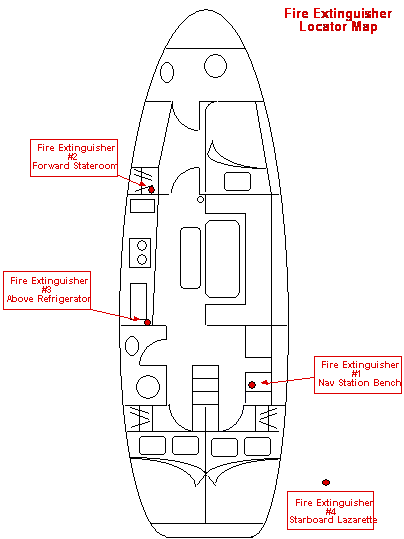Download Boating Tip #36: Fire Extinguishers (PDF format, 34KB)
Fuel + Heat + Oxygen = FIRE
| Class | Use | Water | Dry Chemical | Carbon Dioxide | Foam | Fog |
|---|---|---|---|---|---|---|
| Removes heat by cooling | Stops chemical reaction | Dilutes oxygen | Smothers | Moisture absorbs heat | ||
| A | Common combustible materials (wood, cloth, paper, rubber) | Best choice | Good choice, but aim at base of fire | Good choice | Good choice – separates the O2 from the fuel | Good choice – will cool area so you can get in close to fight the fire |
| B | Flammable liquids & gasses (gas, oil, propane, petroleum products) | Will spread flame | Good choice, but possibility of reflash | Good choice but requires a large quantity of CO2 | Best choice, except for use on alcohol | Good choice |
| C Stop current flow first |
Energized electrical equipment (wiring, appliances, lighting, RADAR) | Poor choice | Good choice, but possibility of reflash, and fine powder residue will damage electronic equipment | Best choice after Halon | Poor choice | Not recommended – use only as a last resort |
| D | Combustible materials (magnesium, aluminum, titanium) | Will explode | Not effective | Not effective | Not effective | Will explode |
You must carry U.S. Coast Guard approved fire extinguishers aboard in sufficient quantity and of the specified type, according to the following chart:
| Boat Length | # of Extinguishers | Type of Extinguisher |
|---|---|---|
| Less than 26 feet | 1 | B – I |
| 26 feet to less than 40 feet | 2 or 1 |
B – I or B – II |
| 40 feet to 65 feet | 3 or 1 + 1 |
B – I or B – I and B – II |
Class BC and ABC dry chemical fire extinguishers are the type most commonly carried aboard small recreational vessels, to put out fuel and electrical fires. The Roman numerals I and II indicate the size of the extinguisher.
Make sure everyone aboard knows the location of all fire extinguishers. Keep the extinguishers in plain sight. Post a diagram of where the extinguishers are located.

Know how to use your portable fire extinguishers. Read the instructions. To use an extinguisher: pull the pin, aim at the base of the fire, squeeze the handle, and sweep from side to side using short bursts.
Examine the extinguishers regularly. Check the pressure level and for signs of leakage. Invert or shake the extinguisher several times to prevent dry chemicals from becoming compacted and sticking to the bottom of the extinguisher. Do not test the extinguisher to see if it works. After using an extinguisher, have it recharged before using it again.
